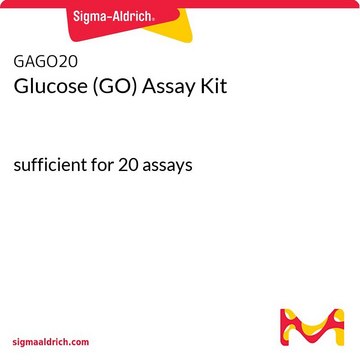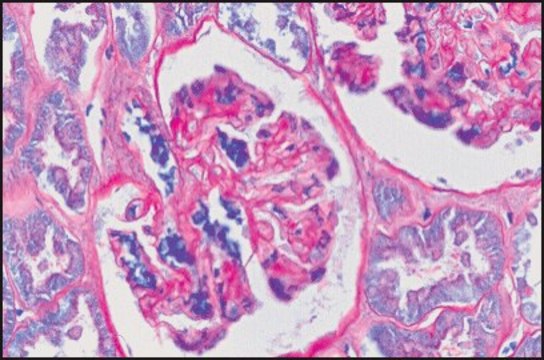MAK016
Glycogen Assay Kit
sufficient for 100 colorimetric or fluorometric tests
Sign Into View Organizational & Contract Pricing
All Photos(4)
About This Item
UNSPSC Code:
12161503
NACRES:
NA.84
Recommended Products
usage
sufficient for 100 colorimetric or fluorometric tests
detection method
colorimetric
fluorometric
storage temp.
−20°C
General description
Glycogen is a branched polymer of glucose that serves as the primary short-term energy storage molecule in animals. Glycogen is primarily synthesized in liver and muscle tissue where it can constitute up to 10% of the weight of liver and 1-2% of the weight of muscle tissue. While muscle glycogen is generally utilized locally, liver glycogen serves as an important buffer to regulate blood glucose levels. Glycogen metabolism is dysregulated in diabetes and the glycogen storage diseases due to inborn errors of metabolism.
Application
Glycogen Assay Kit has been used in glycogen quantification. It has also been used to determine the glycogen content in liver, vastus lateralis and muscle homogenates.
Suitability
Suitable for determining glycogen concentration in various tissues such as liver etc. and cell culture (adherent or suspension cells).
Principle
Glycogen concentration is determined by a coupled enzyme assay, which produces a colorimetric (570 nm)/ fluorometric (λex = 535/λem = 587 nm) product, proportional to the glycogen present.
replaced by
Product No.
Description
Pricing
Signal Word
Danger
Hazard Statements
Precautionary Statements
Hazard Classifications
Resp. Sens. 1 - Skin Sens. 1
Storage Class Code
10 - Combustible liquids
Flash Point(F)
188.6 °F - closed cup
Flash Point(C)
87 °C - closed cup
Regulatory Information
常规特殊物品
Choose from one of the most recent versions:
Certificates of Analysis (COA)
Lot/Batch Number
Don't see the Right Version?
If you require a particular version, you can look up a specific certificate by the Lot or Batch number.
Already Own This Product?
Find documentation for the products that you have recently purchased in the Document Library.
Insulin Signaling in Bupivacaine-induced Cardiac ToxicitySensitization during Recovery and Potentiation by Lipid Emulsion
Fettiplace M R, et al.
Anesthesiology, 124(2), 428-\442-428-\442 (2016)
Madhuri S Salker et al.
Scientific reports, 7(1), 12612-12612 (2017-10-05)
Embryo implantation requires a hospitable uterine environment. A key metabolic change that occurs during the peri-implantation period, and throughout early pregnancy, is the rise in endometrial glycogen content. Glycogen accumulation requires prior cellular uptake of glucose. Here we show that
Nady Golestaneh et al.
Journal of translational medicine, 14(1), 344-344 (2016-12-22)
Study of age related macular degeneration (AMD) has been hampered by lack of human models that represent the complexity of the disease. Here we have developed a human in vitro disease model of AMD to investigate the underlying AMD disease
Long-term obestatin treatment of mice type 2 diabetes increases insulin sensitivity and improves liver function.
Kolodziejski P A, et al.
Endocrine, 56(3), 538-550 (2017)
Ni Zeng et al.
PloS one, 15(4), e0230044-e0230044 (2020-04-03)
LEFTY2 (endometrial bleeding associated factor; EBAF or LEFTYA), a cytokine released shortly before menstrual bleeding, is a negative regulator of cell proliferation and tumour growth. LEFTY2 down-regulates Na+/H+ exchanger activity with subsequent inhibition of glycolytic flux and lactate production in
Our team of scientists has experience in all areas of research including Life Science, Material Science, Chemical Synthesis, Chromatography, Analytical and many others.
Contact Technical Service


